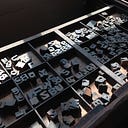Weird South: Inside the Garden of ‘Outsider Art’
The Paradise Garden of Rev. Howard Finster: Summerville, GA
What’s the Attraction?
Two acres of residential property that have been devoted to housing and displaying 50+ years worth of found or discarded materials that were repurposed as mediums, canvases, and subjects as part of one man’s spiritual call ‘to create sermons in art’.
-Some have likened it to “outsider art,” art brut, or naive art
How it’s Weird:
On the surface, it is a spectacle of one man’s lifetime of religiously inspired folkart that he created on his property in Summerville Georgia. As my mom who joined me on this excursion put it, “Just driving by [it], you’d mistake it for a junk yard.” So why has this man’s ‘junk-art’ been featured on the Johnny Carson show, on the Talking Heads album covers, and in the High Museum of Art? Perhaps this ‘must-see’ location of North Georgia deserves a closer look?
How it’s Southern: It’s kind of a mash-up of two things:
-The South, especially during the 20th century, can be seen as an ideal incubator for “outsider artists.” As the Sarah Boxer Atlantic article describes, there is a commonality among established “outsider artists” as having come from a certain tragic or troubled background, and with no academic or main-stream influence or classical education in art, they’re artwork is nevertheless fully established and often extremely prolific. In short, these artist were untouched or uninfluenced by the popular art world. These artist all eventually experience a transformation and / or call from a Higher Power to create art. Southern Outsider Artists like Bill Traylor and Charles Shannon?, and Howard Finster follow this pattern and make up the two categories of Minimalist (Traylor) or, the more common example, Manic (Finster).
How it’s Southern (cont.):
-The found materials I saw in use in Paradise Gardens included everything from plastic milk jugs, bicycles, laundry machines, plastic toy figurines, faded icons and relics of Jesus, Mary, the cross, to one Mrs. Robinson’s rusted haircurling iron. All of this, and lots and lots of shiny, light reflecting mirrors. The common denominator between these items, other than the phrase: “one man’s trash is another man’s — ,” is that each and every piece seemed to be very much taken from Finster’s local surroundings in the still relatively rural areas of North West Georgia. In as much as it is an outdoor gallery of religious iconography, it is equally a gallery of the objects used and discarded by this area of the U.S. South.
Complicating the idea of Howard Finster being a true “outsider artist” is the rise in notoriety he received while he was still living. The generally accepted definition of which is reserved for those artists that are “untouched” or uninfluenced by the critical or “insider” art world. Before Howard Finster was featured in the High Mueseum of Modern Art in Atlanta, his ‘Garden’ had already been a location for people to visit, he had already been on the Johnny Carson Show, and he had even done album art for several muscians and bands; namely The Talking Heads and the Athens, GA-group R.E.M. The video included an R.E.M.’s music video for the track “Radio Free Europe” which was actually shot at Howard Finster’s Paradise Gardens.
Read more about this from Sarah Boxer’s incredibly informative Atlantic Magazine article:
Howard Finster, ‘Man of Vision’
Analysis:
Something I did not expect to feel in visiting this attraction was the intense sense of tranquility and ‘halcyon’ -like mood that the Garden’s profusion and variety of Finster’s ‘manic’ style or ‘naive art’ evoked for me. The evangelical aspects and overty religious subject matter of the art may, for some visitors, be all that is evident here, and thereby alienate or isolate the attraction as one that can only be enjoyed by people of that faith. This alienation or isolation reminded me of my initial hesitation with visiting the architecturally mind-blowing BAPS Hindu Temple in Lilburn, GA. Serving two very different capacities, both BAPS and Paradise Gardens are places open to the public (and not exclusively to followers of their respective religions) that offer visitors access to sacredly-inspired places that function as both places of worship but also as sanctuaries for viewing and being in the presence of so much wonderfully beautiful and mesmerizing profuse art. At both places your eyes are never at ease, because everywhere you look: the ceiling, the floor, even a weather-worn shack has been sculpted or crafted into something not only visually beautiful but obviously deeply meaningful to the artist. This, I believe, is what creates and achieves the halcyon and serene atmosphere that I described in my visit to the temple, as well as what I experienced here at Paradise Gardens.

